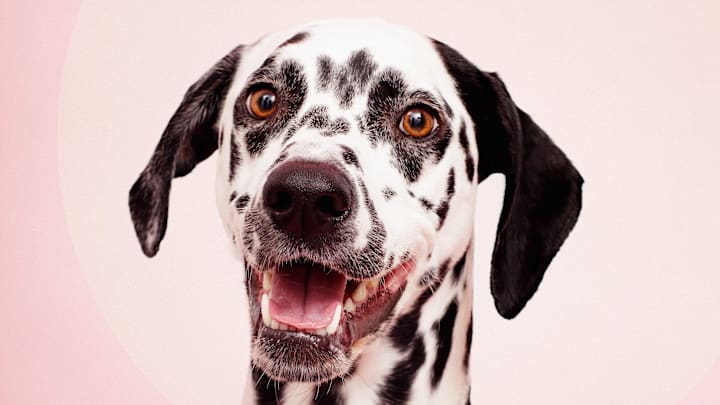You’ve probably seen this spotted dog on the back of a fire truck or in the movies, but how much do you really know about the unusual breed?
1. The origins are mysterious.
Like many other old breeds, the origins of the Dalmatian are hard to pin down. Some people believe the dogs come from Dalmatia, a region in modern day Croatia. The canines were dogs of war and used as sentinels. Others believe the dogs are as old as the ancient Egyptians—paintings of spotted dogs running by chariots can be found in the tombs.
2. Dalmatians have many monikers.
The old breed has taken on a lot of names over the years, including the English Coach Dog, the Carriage Dog, the Plum Pudding Dog, the Fire House Dog, and the Spotted Dick.
3. Dalmatians are all-purpose dogs ...
The breed is very versatile and has been used for many purposes over the years. They’re talented sporting dogs, and are used as birding dogs, trail hounds, boar hunters, and retrievers. What’s more, thanks to an excellent memory and interesting coat, the pooches made good performers on the stage and in the circus.
4. ... But they’re best known as firedogs.

Dalmatians have many talents, but they’re possibly best known for their skills as coaching dogs. The canines get along famously with horses, making them the ideal dog to run alongside carriages. The helpful Dals warded off stray dogs, guarded the coach at stops, and most importantly, kept the horses calm.
This job eventually translated to the firehouse, where Dalmatians would run behind fire trucks. Horses were skittish around fire, but the Dals kept them composed. Their distinct features also make them a great mascot, so you can still find the dogs riding in modern fire trucks today. As a bonus, they’re also excellent ratters and keep firehouses pest-free.
5. Budweiser still uses Dalmatians.
Keeping with the tradition of coach dogs, Budweiser keeps three Dalmatians to travel with the Clydesdale hitches. The breed has been associated with the brewery since 1950, when a Dal was introduced as the Budweiser Clydesdales’ mascot.
6. George Washington loved Dalmatians.
The first president was an avid dog fan and was known to be an early breeder of Dals. His coach dog was a Dalmatian named Madame Moose.
7. Dalmatians can have spots everywhere ...
Dalmatians are distinct for their piebald pattern. Usually these spots are black or brown, but sometimes they can be lemon, blue, or brindle. Every Dal is different, but most have these marks all over their body. If you open up a Dal’s mouth, you’ll even find spots there.
8. ... But have none when they’re born.

Despite being covered in spots in adulthood, puppies are born snow white. Pups generally don’t grow their trademark spots until about four weeks. This news might come as a shock, as it directly negates what the Disney movie 101 Dalmatians might have suggested.
9. 101 Dalmatians did some damage to the breed.
Besides giving viewers an inaccurate idea of what the puppies looked like, the movie encouraged a lot of people to go out and buy one of the dogs they saw on the big screen. Unfortunately, the Dalmatian boom led to a lot of Dals in shelters. Families found that the breed shed a lot and didn’t always get along with children. The pups need a lot of attention and training, and many adopters weren’t ready for the responsibility. As a result, many Dalmatians found themselves without a home.
Increased demand for the breed also led to a lot of amateur breeders and puppy mills, flooding the market with dogs with health problems and aggressive behavior. Shelters urged people not to adopt dogs without first doing their research.
10. Deafness is a problem.
If your Dal seems to be ignoring you, it could just be because it can’t hear you. Around 30 percent of all Dalmatians are have some form of deafness. Breeding dogs with their kind of spotted coat can lead to a lack of mature melanocytes (melanin producing cells) in the inner ear. Without these, dogs can have difficulty hearing. Dogs with larger patches of black are less likely to be deaf.
11. Dalmatians are willful and independent.
Dalmatians are very intelligent and, as a result, very independent dogs. Without the proper training, they can be willful and stubborn. The demanding dogs need a lot of attention and exercise. Don’t get a Dal unless you’re ready to wake up early and go for long walks.
A version of this story originally ran in 2016; it has been updated for 2022.
